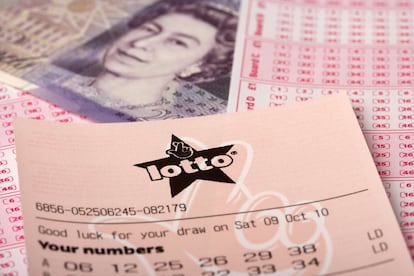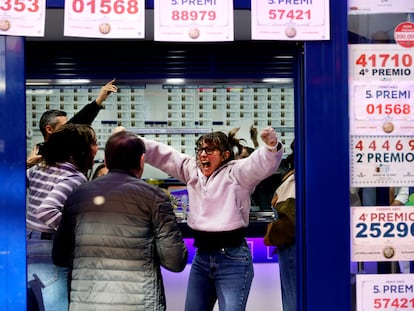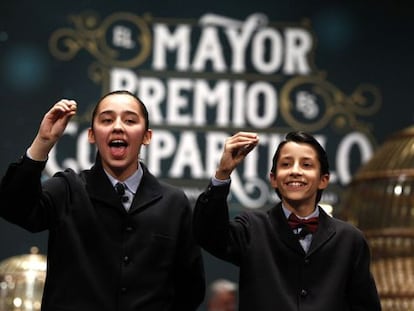How to guarantee a prize in the UK Lottery
Two British mathematicians demonstrated that, by buying 27 tickets, it is possible to secure a prize in the draw, using so-called ‘lottery designs’ but with no guarantee of a profit

A few months ago, several news outlets — including reputable publications as well as tabloids — claimed that you only need to buy 27 tickets to guarantee a win in the U.K. National Lottery. As the winners of Spain’s Christmas Lottery continue to celebrate, this seems like a suitable time to address the mathematics behind the headlines.
The heart of the story is a recent discovery in combinatorics that was made by David Cushing and David Stewart, two mathematicians from the University of Manchester. Their results — currently under peer review, but available in a preprint — involve interesting combinatorial objects called lottery designs, which are certain collections of subsets of the numbers from 1 to n. As an example, if we consider the numbers {1, 2, 3}, a collection of three subsets would be {{1,3}, {1,2},{2, 3}}. To be a lottery design, such a collection must satisfy certain extra properties.
More precisely, a lottery design for the parameters (n, k, t) is defined as a collection C of subsets of k elements of V = {1, 2, ...,n}, with the property that for any subset W of k numbers from V, there is a subset contained in C which shares at least t elements in common with W. If we look at the subsets as tickets in a lottery, where k winning numbers are drawn from n numbers, then a lottery design is just a set of tickets guaranteed to have at least t numbers in common with the winning numbers.
Naturally, an ideal lottery design is one which uses the smallest possible number of tickets, and this minimal number is denoted as L(n, k, t). For example, the number L(56, 6, 2) is the smallest number of tickets one would need in order to guarantee at least two matching numbers in a hypothetical lottery where six winning numbers are drawn from 56. This is exactly how the U.K. National Lottery works, and since matching two numbers is how you win the smallest prize, it follows that L(56, 6, 2) is precisely the smallest number of tickets needed to guarantee a prize in this lottery. Cushing’s and Stewart’s result says that this number is equal to 27.
In general, it is extremely difficult to find the exact values of L(n, k, t), and in most cases mathematicians have only been able to approximate these numbers to within a range of possible values. Before this recent work, the best known lower bound for L (56, 6, 2) was 23, meaning that we need to buy at least 23 tickets to guarantee a win. In 1998, A. Bate and G. H. John van Rees computed the exact values of L for parameters (n, 6, 2) for all n less than or equal to 54 (incidentally, their result tells us precisely how many tickets you need to buy in the Texas Lottery in order to guarantee a win, but somehow the media didn’t consider this to be newsworthy).
Cushing and Stewart extended the techniques used by Bate and Van Rees, calculating L(n,6,2) not only for n = 56, but for all n up to 61. To do this, they first proved that a lottery design of size 27 exists, using techniques from finite geometry, a branch of geometry that deals with spaces containing a finite number of points. Their construction uses something called the Fano plane, which is a plane containing seven points and seven lines — with each line consisting of three points — with the following properties: any two points lie in exactly one line and any two lines intersect in exactly one point. To make a lottery design, they combine three Fano planes with two other finite planes. By associating a unique pair of numbers with each point, each line is then labeled with a unique set of six numbers, and the special properties of these finite planes ensure that this collection of sets constitutes a lottery design of size 27.
Now comes the hard part. In order to show that the size of this design is minimal, they proved that there is no lottery design of 26 or less. To do this, Cushing and Stewart used a logic programming language called Prolog. To write and execute a program in Prolog, you enter a list of rules to work with, and then ask questions based on those rules. In principle, you could specify the definition of a lottery design and ask if one of size 26 exists. However, with today’s limitations on computating speed, this could take decades or even centuries. Using a clever combination of upper bounds, lower bounds, and assorted combinatorial techniques, Cushing and Stewart were able to narrow down the search space, guiding the Prolog engine to a definitive answer.
Of course, the two immediate questions are, “can this be used to win lotteries?” and “what about El Gordo?” The answer to both questions, unfortunately, is no. Playing these 27 tickets is not a good strategy for winning money in the British lottery. It costs £54 to buy the tickets, and the only guaranteed prize (for matching two of the winning numbers) is a randomly selected ticket in the next draw, which is practically worthless. Indeed, Cushing and Stewart conducted a field test with a total loss of £54, concluding that “this unfortunate incident therefore serves both as a verification of our result and of the principle that one should expect to lose money when gambling.” Alas, such statements rarely make it into the headlines.
Regarding the Spanish Christmas Lottery, its very structure ensures that no such strategy could possibly work. Unlike the U.K. (and most other conventional lotteries), there is a separate random draw for each winning number, instead of basing the prizes on matching numbers with a single draw. Thus, I conclude with the gentle recommendation that, if you absolutely must play, please do so responsibly.
Richard Mandel is a postdoctoral researcher at the Max Planck Institute for Software Systems (Germany)
Tu suscripción se está usando en otro dispositivo
¿Quieres añadir otro usuario a tu suscripción?
Si continúas leyendo en este dispositivo, no se podrá leer en el otro.
FlechaTu suscripción se está usando en otro dispositivo y solo puedes acceder a EL PAÍS desde un dispositivo a la vez.
Si quieres compartir tu cuenta, cambia tu suscripción a la modalidad Premium, así podrás añadir otro usuario. Cada uno accederá con su propia cuenta de email, lo que os permitirá personalizar vuestra experiencia en EL PAÍS.
¿Tienes una suscripción de empresa? Accede aquí para contratar más cuentas.
En el caso de no saber quién está usando tu cuenta, te recomendamos cambiar tu contraseña aquí.
Si decides continuar compartiendo tu cuenta, este mensaje se mostrará en tu dispositivo y en el de la otra persona que está usando tu cuenta de forma indefinida, afectando a tu experiencia de lectura. Puedes consultar aquí los términos y condiciones de la suscripción digital.
More information
Últimas noticias
Chris Martin, Taylor Swift, Elijah Wood and other famous wedding ‘crashers’
‘How does it feel to be a failure?’: Elizabeth Berkley’s journey from ‘Showgirls’ ridicule to vindication
The story of the Málaga virus: The code that haunted Google’s cybersecurity center director for 30 years
The impact of Ecuador’s mega-prison: A polluted river, cleared forests and military checkpoints
Most viewed
- Christian Louboutin: ‘Young people don’t want to be like their parents. And if their parents wear sneakers, they’re going to look for something else’
- The low-cost creative revolution: How technology is making art accessible to everyone
- Liset Menéndez de la Prida, neuroscientist: ‘It’s not normal to constantly seek pleasure; it’s important to be bored, to be calm’
- All the effects of gentrification in one corner of Mexico’s Colonia Roma
- December Social Security and SSI payments: Dates, double checks and the 2026 COLA increase










































